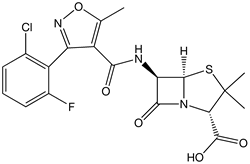Flucloxacillin
Flucloxacillin (INN) or floxacillin (USAN) is a narrow spectrum beta-lactam antibiotic. It is used to treat infections caused by susceptible Gram-positive bacteria. Notably, it is active against beta-lactamase-producing organisms such as Staphylococcus aureus, which would otherwise be resistant to most penicillins. It is very similar to dicloxacillin and these two agents are considered interchangeable. Flucloxacillin is available under a variety of trade names including Flopen (CSL) and Floxapen (GSK). more...
Mode of action
Like other β-lactam antibiotics, flucloxacillin acts by inhibiting the synthesis of bacterial cell walls. It inhibits cross-linkage between the linear peptidoglycan polymer chains that make up a major component of the cell wall of Gram-positive bacteria.
Medicinal chemistry
Flucloxacillin is insensitive to beta-lactamase (also known as penicillinase) enzymes secreted by many penicillin-resistant bacteria. The presence of the isoxazolyl group on the side chain of the penicillin nucleus facilitates the β-lactamase resistance, since they are relatively intolerant of side-chain steric hindrance. Thus it is able to bind to penicillin binding proteins (PBPs) and inhibit peptidoglycan crosslinking, but is not bound by or inactivated by β-lactamases.
Clinical use
Flucloxacillin is more acid-stable than many other penicillins and can be given orally, in addition to parenteral routes. However, like methicillin, it is less potent than benzylpenicillin against non-β-lactamase-producing Gram-positive bacteria.
Flucloxacillin has similar pharmacokinetics, antibacterial activity and indications to dicloxacillin and the two agents are considered interchangeable. It is believed to have higher incidence of severe hepatic adverse effects than dicloxacillin, but a lower incidence of renal adverse effects. (Rossi, 2006)
Available forms
Flucloxacillin is commercially available as the sodium salt flucloxacillin sodium, in capsules (250 or 500 mg), oral suspensions (125 mg/5 mL or 250 mg/5 mL), and injections (powder for reconstitution, 250, 500 and 1000 mg per vial).
Indications
Flucloxacillin is indicated for the treatment of infections caused by susceptible bacteria. Specific approved indications include: (Joint Formulary Committee, 2005; Rossi, 2006)
- Staphylococcal skin infections and cellulitis – including impetigo, otitis externa, folliculitis, boils, carbuncles, and mastitis
- Pneumonia (adjunct)
- Osteomyelitis, septic arthritis
- Septicaemia
- Empirical treatment for endocarditis
- Surgical prophylaxis
Flucloxacillin has relatively poor activity, as noted above, against non-β-lactamase-producing bacteria including Streptococcus pyogenes. Therefore empirical therapy for significant cellulitis often involves dual-therapy to cover both staphylococci and streptococci, using either penicillin or ampicillin in addition to flucloxacillin. The latter is available as a standardardised combination preparation co-fluampicil (flucloxacillin+ampicillin).
Precautions/contraindications
Flucloxacillin is contraindicated in those with a previous history of allergy to penicillins, cephalosporins or carbapenems. It should also not be used in the eye, or those with a history of cholestatic hepatitis associated with the use of dicloxacillin or flucloxacillin. (Rossi, 2006)
Read more at Wikipedia.org



